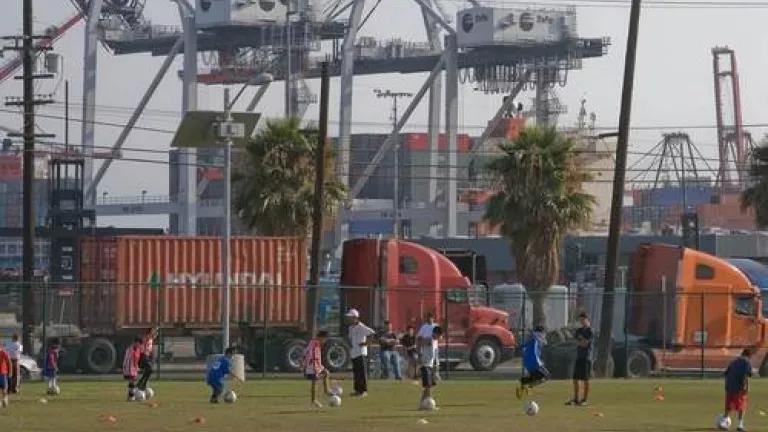
Standing in a Safeway distribution center in Upper Marlboro, Maryland, with an 80,000–pound fuel-efficient tractor-trailer in the background, President Obama today announced plans to continue his fuel-efficiency success with a second round of efficiency standards for heavy and medium-duty trucks.
Big trucks like these—18-wheelers, garbage haulers, big delivery trucks, city buses and the like—are the vehicles we depend on to move things around, from groceries to pre-fab houses. But they’re also the energy hogs of the road, consuming 20 percent of all the oil we use for transportation, and churning out 20 percent of the carbon pollution from the transportation sector: an outsize contribution, considering they make up only 4 percent of vehicles on the road. Making trucks go farther on a gallon of gas is not only a better way to get from Point A to Point B, but a critical part of the President’s plan to cut carbon pollution.
Fuel efficiency standards for vehicles represent the single largest action the United States has taken to address climate change. And they’ve been tremendously successful. Clean car standards for passenger vehicles, developed in conjunction with the auto industry, which call for an average of 54.5 mpg by 2025, are already saving drivers thousands of dollars at the pump. They’ve spurred a burst of innovation and hiring in the auto industry. By 2030, they’re expected to save consumers $1.7 trillion in fuel costs, while reducing carbon pollution by 580 million metric tons—the equivalent of the emissions from 140 coal-fired power plants.
The first efficiency standards for heavy duty trucks, set by the Obama administration in 2011, covered the model years 2014 to 2018. They’re expected to cut carbon pollution by more than 50 million metric tons a year and save more than 390,000 barrels of oil per day by 2030. They’ll also save truck owners and operators about $50 billion in fuel costs.
That was just the beginning. While pollution from cars and light trucks has started to decline, freight truck emissions are still rising. The second round of truck standards, which the President directed the EPA and the DOT to create, will be key to keeping trucks on track to get cleaner.
We already know how to do this. According to the National Academy of Sciences, we have cost-effective technologies today which can cut fuel consumption and carbon pollution in trucks five percent a year. The American Council for an Energy Efficient Economy (ACEEE) says that the U.S. on-road trucking fleet can cut its oil consumption 1 million barrels per day in 2030, which is roughly the amount of oil we imported from the Persian Gulf in 2012.
When trucks get cleaner, we all benefit, from the cleaner air and the reduction in carbon pollution that is fueling extreme weather. We benefit from the fact that truckloads of tomatoes or wind turbine parts go farther on each gallon of gas as they travel from farms and factories to stores and construction sites. And just as clean car standards have revitalized the American auto industry, which has added more than 370,000 jobs since the low point of 2009, setting the bar higher for trucks will continue to encourage innovation in the industry.
The benefits of fuel-efficiency standards reach a wide variety of constituencies. That’s why Obama’s announcement was applauded not only by environmental groups, but by labor and industry, too. Like all moves to cut waste and boost efficiency, it’s a solution that works from an economic and environmental perspective.
Clean truck standards are a smart way forward to cleaner air, less carbon pollution, and a cheaper, more efficient way to get things where they need to go.
